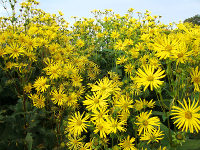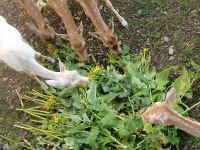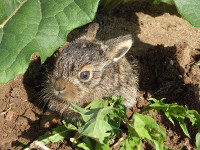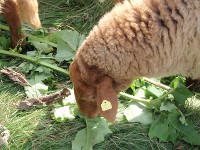Usage
1. Usage for Biogas Production
The cup- plant can be used as an excellent co-substrate for biogas production (methane and carbon dioxide) in a biogas plant (togehter with liquid manure). The methane content of biogas varies by 55 %. In the laboratory a yield of 310 l methane per kg dry organic matter was achieved. This is about 10 % less than for silo maize (but there is a wide range of variation). Thus, per hectare crop area and an average production of 150 dt dry organic matter the production of methane with cup-plant is about 4650 m3. On soils with sufficient water supply and fertilisation yields up to 23 tons dry matter per hectare are possible. In 2013 the first large fields (up to 1 ha) at the University of Bayreuth were harvested and the yield was quantified. Currently the Bayreuth department of agriculture is doing a product profitability calculation for the usage of crops for biogas production. First results show that the cup-plant provides similar or slightly higher profit contribution than silo maize. (refer to: Comparison of costs of production Maize vs. Cup-plant).2. Usage as shredded Material for Silage
Currently there is a testing phase for feeding the shredded plants to cattle. Analyses of the clippings of Silphium perfoliatum were made in order to compare material of two harvests with material of only one harvest per year (from a crop field in Bayreuth near Geigenreuth). The results show the following crude protein contents per 100 g dry organic matter (TM):Two harvests:
1st cut June 13, 2013: crude protein content 11,9 %, TM: 8,9 %
2nd cut August 29, 2013: crude protein content 9,2 %, TM: 13,9 %
one harvest:
harvest August 29, 2013: crude protein content 3,45 %, TM: 27,2 %
According to these analyses Silphium perfoliatum shows high protein contents that seem to make it very suitable for feeding to cattle and dairy cows. The high water content of freshly harvested plants in the version with two harvests can be reduced by a short wilting phase after cutting, thus ensilage is also possible.
3. Direct Feeding to Cattle, Sheep, Pig, Goat and Fallow Deer
The cup-plant can be harvested twice a year for cattle feeding (and other ruminants): 1st cut beginning of June, 2nd cut beginning of September. Between harvests fertilization is possible. If there is only a single harvest in September, the stems and lower leaves are already to hard for feeding and are not or only reluctantly eaten by the cattle.
Due to the longer growing period (in comparison to maize) and the permanently living roots, which penetrate a larger soil volume, the contents of minerals and trace elements are higher in cup-plant than in maize. This is important if cup plant is used as a fodder. Thus fewer amounts of expensive concentrate feed and chalk is necessary.
The high water content of the plants in June is no problem if the plant is ensiled after a short wilting phase. In the mediterranean climate of Chile cattle are driven into cup-plant stands during the dry summer period. There they feed on the leaves and spare the hard stems. Cup-plant does not contain any substances poisonous for cattle. In former German Democratic Republic (GDR) rabbits were fed with cup-plants.
4. Bee Pasture: Source of Honey and Nectar
The cup-plants are in bloom for about 8 or more weeks, from end of July to end of September depending on the variety being cultivated. During this period, the attractive flowers are visited by large numbers of different pollinators (bees, bumblebees, syrphid flies, butterflies, etc). They offer alternative nectar and pollen sources at a time when the regular sources from the meadow are scarce (due to intensive agricultural use of the meadow today: repeated mowing and interim fertilization resulting in herb-poor grass fields). Alternative nectar and pollen-rich flowers are, therefore, sought after by bees and other insects.Cup-plant honey is relatively rich in fructose, hence it hardly crystallizes or only with delay.
During late summer and early autumn 2013, an experiment was conducted with a test bee-hive, which was set on a weighing balance and established next to a 1 ha flowering cup-plant field. The 2013 summer was unusually cold and dry, and hence the amount of collected nectar and pollen were low. Thus, the general population of bees in the hives declined due to mortality. In comparison, the decline in the test bee-hive was lower due to improved nutrition supply and the colony entered into hibernation with a higher number of individuals.
Further studies on honey yields from cup-plant fields are needed.















